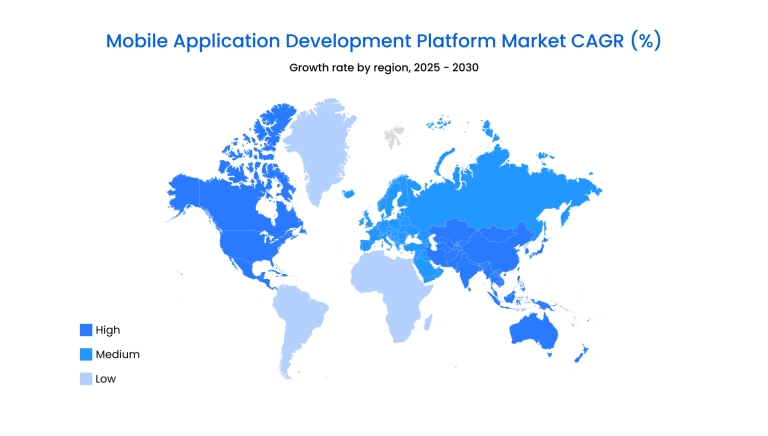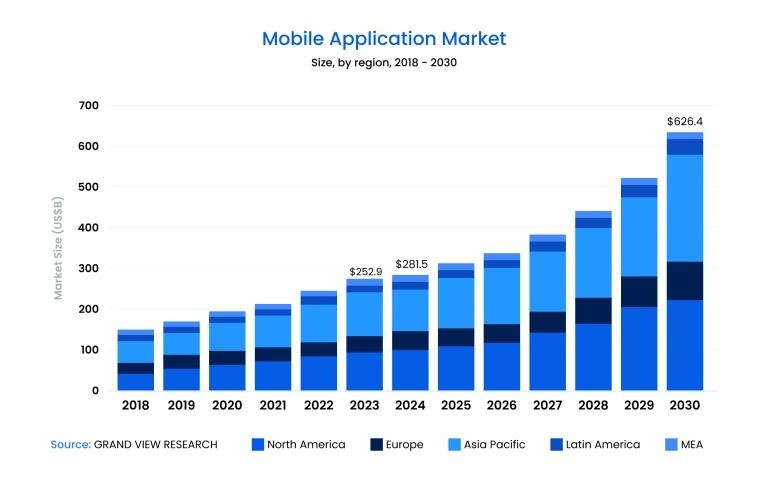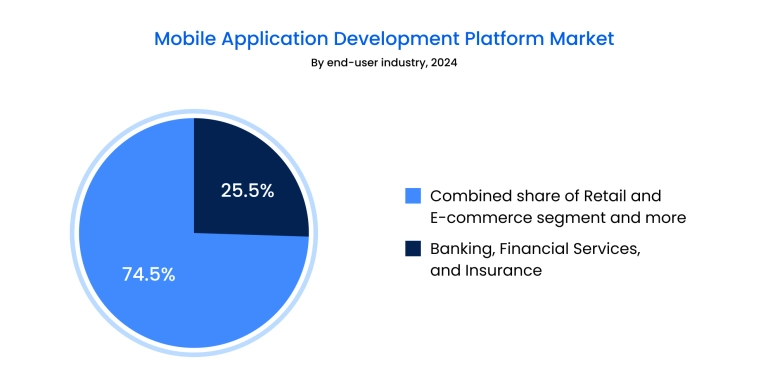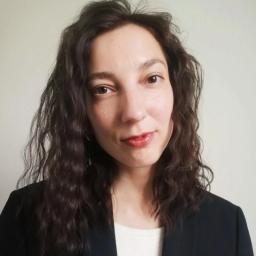The mobile industry is entering its most transformative phase yet. As 5G networks expand and AI-driven tools reshape workflows, businesses are rethinking how mobile experiences are designed, built, and scaled.
The global mobile application development platform market will nearly double from USD 243.5 billion in 2025 to USD 480.6 billion by 2030, growing at a 14.56% CAGR. This acceleration is fueled by the demand for cross-platform, cloud-native, and low-code ecosystems that cut costs while speeding up innovation, a core reflection of emerging mobile app development trends.
In 2025 and beyond, developers will see deeper integration of AI-assisted coding, smarter backend orchestration through microservices, and a new wave of immersive interfaces powered by AR and spatial computing.
These shifts aren't just technical; they redefine how companies deliver value, maintain compliance, and personalize engagement across industries from healthcare to fintech.

This article unpacks the most critical application development trends shaping the mobile landscape through 2025–2030. You'll learn which technologies matter most, which markets are driving adoption, and how to align your product strategy with what's coming next.
Whether you're modernizing legacy infrastructure or exploring advanced mobile development services , this guide highlights where the real opportunities lie.
By the end, you'll have a clear, actionable view of the app development trends defining the next generation of digital products – and what steps to take today to stay ahead.
Current state of mobile app development market
The global mobile application market is expanding rapidly, driven by new mobile development trends that combine AI, IoT, and data analytics into user experiences. The mobile application market – which includes consumer and enterprise apps – was valued at USD 252.89 billion in 2023 and is projected to reach USD 626.39 billion by 2030, growing at a 14.3% CAGR.

Asia Pacific leads with 32% of global revenue, followed by North America's steady growth. The Apple App Store accounts for over 62% of global app revenue, and gaming remains the top segment with 40%+ share. These figures show how mobile ecosystems evolve toward integrated, personalized experiences.
Key drivers of growth
Several forces shape the latest mobile app development trends:
- Smartphones and internet access – billions of users and cheap data plans accelerate downloads worldwide.
- AI integration – smarter interfaces powered by AI/ML development enhance prediction, security, and engagement.
- AR/VR adoption – gaming and e-learning apps lead immersive experiences.
- Pandemic-driven demand – health, education, and remote-work apps retain high daily use.
Industry dynamics
The industry is in a medium but accelerating growth stage. Despite fragmentation, innovation is high, with frequent launches and strong competition. Developers rely on AI, automation, and microservices – trends defining the future of mobile app development.
Key takeaways:
- Innovation level: High, supported by modular architectures.
- Regulations: Increasing data transparency requirements.
- End-user concentration: Expanding across new verticals.

User behavior and regulation
User engagement spans entertainment, retail, gaming, and productivity. Younger audiences dominate gaming and social apps, while professionals drive demand for finance and utility tools.
Global privacy laws (GDPR, CCPA) now require explicit consent for data collection, making transparency and compliance central to trends in mobile app development .

Key mobile app development trends in 2025-2028
The mobile app development market is entering an advanced stage where intelligence, prediction, and immersion drive value more than interface polish. As 5G coverage expands and AI frameworks become native to development environments, businesses are using mobile apps not just to reach users but to predict and adapt to them.
Between 2025 and 2028, leaders will prioritize tools that automate, personalize, and integrate seamlessly across platforms, setting the tone for a decade of connected experiences.
1. Artificial intelligence
Artificial intelligence has moved beyond development support – it now defines app behavior and user experience. Mobile platforms increasingly embed AI models to personalize interactions , automate content, and make real-time decisions inside the product itself.
Analysts note that as AI systems mature, mobile apps will shift from reactive tools to self-optimizing ecosystems, capable of adjusting workflows and recommendations autonomously.
Use cases
- Peloton (Fitness, US)
Peloton's Guide uses AI-powered computer vision to analyze body movement and track form during strength workouts. The device identifies which muscle groups are engaged and provides on-screen feedback to improve technique. It also personalizes training by recognizing patterns in user performance and recommending future sessions accordingly.
- HSBC (Banking, Global)
HSBC employs Google Cloud's AI and machine-learning tools to enhance anti–money laundering and fraud detection systems. The platform scans over a billion transactions monthly, using AI models to identify suspicious activity with greater precision and significantly cut false alerts. This partnership improves both compliance efficiency and fraud prevention accuracy across HSBC's global network.
AI's rise signals a structural shift – it's no longer an enhancement but the foundation of new technology in mobile application development, setting the benchmark for speed, accuracy, and personalization.
2. Predictive UX
User interfaces are shifting from static design to predictive orchestration. AI and analytics interpret real-time context – location, time of day, behavior history – to adjust content and pricing instantly.
Weekly subscription models make up 47% of total app-store revenue, while free trials raise lifetime value by 64%, proving that adaptive experiences drive monetization.
Use cases
- Netflix (Entertainment, US)
Netflix's mobile app uses reinforcement-learning algorithms that adjust recommendations and even thumbnail artwork for each viewer. The system analyzes behavior patterns and viewing times to predict what users are most likely to watch next, driving roughly 80% of total viewing activity.
- Spotify (Music, Sweden)
Spotify personalizes listening through models that process tempo, genre, time of day, and user context. Features like "Daily Mix" and the "DJ AI" voice assistant continuously adapt in real time, using playback data from over 600 million monthly users to refresh playlists and sustain engagement.
- Zalando (E-commerce, EU)
Zalando applies machine-learning models for predictive sizing and individualized product ranking. Combining purchase history with return data, its algorithms reduced clothing return rates by about 6%, as reported in the company's 2023 tech blog – improving customer satisfaction and logistics efficiency across Europe.
Predictive UX is becoming a baseline capability in mobile ecosystems, combining behavioral science with continuous A/B model training to increase relevance and retention.
3. Spatial computing
While the "metaverse" hype has faded, experts highlight how spatial computing has matured into measurable, revenue-generating deployments. Grand View Research data projects sustained growth as 5G networks, GPU optimization, and new hardware like Apple Vision Pro enable high-fidelity augmented reality experiences across devices.
Use cases
- IKEA (Retail, Sweden)
IKEA's AR app – IKEA Place – allows users to preview furniture in their space using ARKit/ARCore. According to IKEA's data, use of AR previews is associated with approximately a 20% reduction in product returns and 35% increase in online sales.
- L'Oréal (Beauty Tech, France)
L'Oréal's ModiFace AR platform powers live, AI-enabled virtual try-on within its apps and retail partners like Amazon. The AR engine produces realistic shade matching and allows users to visualize cosmetics before buying. By 2023, L'Oréal reported over 100 million virtual try-on sessions, more than double the figure from 2022.
- Boeing (Manufacturing, US)
Boeing uses AR smart glasses with Upskill's enterprise software for aircraft wiring assembly. According to IoT Integrator, this reduces wiring production time by 25% and minimizes error rates by overlaying real-time instructions in the technician's view.
Spatial computing bridges the physical and digital worlds with quantifiable ROI, signaling a decisive shift from experimental AR to scalable enterprise integration.
4. Superapps
Super-apps have evolved from regional innovations into global digital ecosystems. They merge messaging, payments, e-commerce, and financial services into one mobile interface – creating a "one-stop" experience that keeps users inside a single brand environment.
Analysts note that these integrated models drive stronger retention and higher transaction volumes than single-purpose apps, making them the blueprint for next-generation mobile ecosystems.
Use cases
- WeChat (Social & Commerce, China)
WeChat remains the benchmark for super-app functionality, shaping nearly every aspect of daily life in China. As of early 2025, it counts around 1.427 billion monthly active users, with over 3.7 million Mini Programs hosted on its platform – covering services from payments and food delivery to healthcare and government forms.
The app's integration of WeChat Pay and Mini Programs has turned it into a parallel mobile economy, used by individuals and enterprises alike for both transactions and service delivery.
- GoTo / Gojek (Mobility & Commerce, Indonesia / Southeast Asia)
Indonesia's GoTo Group, which owns Gojek, represents Southeast Asia's leading super-app model. What began as a ride-hailing service now spans payments, delivery, e-commerce, and financial products under a single login.
The company's FY 2024 report shows that core gross transaction volume (GTV) grew 66 % year-over-year, while the group reached adjusted EBITDA breakeven for the first time. Gojek's integration with GoPay and Tokopedia services continues to cement its dominance across the region's urban mobility, logistics, and fintech.
- Revolut (Fintech, UK/EU)
London-based Revolut has evolved from a digital bank into a full-fledged financial super-app. It now combines current accounts, stock and crypto trading, cross-border payments, travel insurance, and rewards – all accessible through one interface.
Revolut generated £3.1 billion in revenue in FY 2024, marking 72% year-over-year growth and expanding its user base to more than 52 million customers worldwide. This rapid scaling highlights how fintechs adopt super-app strategies to capture multiple consumer spending and engagement layers.
Super-apps represent the latest mobile app development technologies that fuse infrastructure, payments, and social interaction into seamless digital ecosystems.
5. Low-code and no-code platforms
Low-code and no-code development platforms transform how enterprises design and deploy mobile solutions. By abstracting away traditional coding, these tools allow business users and developers alike to create secure, functional apps through visual interfaces.
Enterprises are adopting LCNC platforms to speed up prototyping, reduce IT backlogs, and give domain experts direct control over digital workflows – a shift redefining how mobile applications are built and maintained across industries.
Use cases
- Siemens (Manufacturing, Germany)
Siemens uses Mendix , its in-house low-code platform, to build industrial and factory-level applications. Mendix helps Siemens deploy apps that access data across systems, enabling decision-making on the factory floor with less IT intervention. Siemens has also built over 100 applications in under a year with Mendix, training thousands of users internally.
- Zurich Insurance (Finance, Switzerland)
Zurich established a Power Platform Center for Enablement (C4E) to help internal teams build and manage low-code apps at scale. This structure is designed to ensure governance, reuse, and sustainable growth of citizen development across its global operations.
Low-code development is no longer a workaround but a new app technology standardizing how enterprises build digital tools at scale without deep-code dependency.
6. Cross-platform frameworks 2.0
Cross-platform frameworks are now vital tools for teams needing to build for iOS, Android, and sometimes web – all from a shared codebase. These toolkits reduce duplication, simplify rollout, and allow more consistent user experiences across platforms.
Use cases
- BMW Group (Automotive, Germany)
BMW uses Flutter for its My BMW and MINI apps, delivering consistent UI and synchronized feature releases across platforms. The app now supports navigation, vehicle data, and remote functions in many regions. According to Nomtek, BMW's Flutter implementation includes building internal pipelines for automated builds, saving development time across markets.
- Alibaba (E-commerce, China)
Alibaba has integrated cross-platform frameworks into parts of its mobile stack. Alibaba's move to cross-platform architecture has helped it scale faster, maintain feature parity across platforms, and reduce development costs while serving millions globally.
Cross-platform frameworks now anchor modern release pipelines – enabling code reuse, consistent UX, and unified maintenance across environments – making them one of the latest mobile app development technologies adopted by global enterprises.
7. 5G & 5G-Advanced
5G has become the invisible infrastructure behind a new generation of mobile experiences. Its speed and stability redefine what's possible for gaming, telemedicine, and connected manufacturing.
Where 4G made mobile media mainstream, 5G's promise lies in eliminating friction: faster response times, higher throughput, and reliable performance even for data-intensive or time-critical applications.
Use cases
- Samsung Medical Center (Telehealth Imaging, South Korea)
Samsung Medical Center uses digital pathology over 5G to accelerate diagnostic reading during surgeries. With 5G-enabled slide scanning and network transmission, they halve turnaround times for frozen section analysis, allowing surgeons to review results from tablets on the go.
- PlayGiga (Cloud Gaming Platform, Spain)
PlayGiga leveraged Intel's compute and 5G ecosystem to deploy a cloud gaming service. The case describes how 5G infrastructure was critical to reducing latency and making streaming games from the cloud viable for telecom operators.
8. Wearables & health tech integration
Wearable devices have become integral to how mobile ecosystems collect and act on health data.
From smartwatches that detect arrhythmias to sensors that track glucose or motion, wearables now bridge the gap between continuous monitoring and clinical care. Their integration with mobile apps turns passive data into actionable insight for prevention, treatment, and wellness.
Use cases
Connected wearables now support remote monitoring for chronic conditions, giving clinicians real-time insight into patient health. For example, Dexcom G7 continuously transmits glucose data to mobile apps, while integration with Apple Health enables long-term trend analysis and alerts for critical values.
- Elderly Monitoring and Fall Detection
Modern wearables use motion sensors and AI to identify falls or abnormal movement patterns in older adults. Apple Watch's Fall Detection automatically alerts emergency contacts or services when it detects a hard fall, a feature credited with saving lives and now part of standard health coverage programs in several countries.
9. Blockchain & data integrity
Blockchain is shifting from experimentation to implementation in healthcare and IoT . Its decentralized structure enables tamper-proof data exchange, transparent audit trails, and programmable automation through smart contracts.
In mobile health, blockchain helps unify fragmented data from devices, ensuring that patient records, wearable streams, and clinical updates stay secure and verifiable.
Use cases
- Avaneer Health (Health, US)
Founded by a consortium including Aetna (CVS Health), Anthem (Elevance Health), Cleveland Clinic, and PNC Bank, Avaneer Health uses Hyperledger Fabric and FHIR APIs to enable secure, peer-to-peer data exchange across healthcare organizations.
The blockchain-based network eliminates intermediaries in claims, prior authorizations, and eligibility checks, allowing participants to verify and share data directly while maintaining full privacy and compliance.
In 2024, the company raised $50 million from its founding members to expand adoption, reporting faster claims reconciliation and more transparent interoperability between insurers and providers.
10. Privacy-first and decentralized identity in app architecture
Privacy has become a central pillar of mobile app design. Decentralized identity (DID) frameworks and on-device processing allow users to authenticate, store, and share credentials without sending sensitive data to external servers. This model is being driven by both regulation and consumer demand for data ownership.
Use cases
- Apple (Hardware & Software, US)
Apple's privacy updates now process sensitive data like facial recognition and predictive typing fully on-device. Features such as App Tracking Transparency and Passkeys eliminate shared passwords and reduce server-side risks.
- World Wide Web Consortium (Standardization, Global)
The W3C Decentralized Identifiers specification defines the open global standard for portable, user-controlled identity, used by companies including IBM and Mastercard in digital wallet pilots.
11. Sustainability and green app engineering
Developers are embedding sustainability goals directly into app design, optimizing for lower energy consumption and carbon transparency. "Green coding" now spans hardware optimization, network efficiency, and real-time carbon tracking dashboards.
Use cases
- Salesforce (Enterprise SaaS, Global)
Salesforce's Net Zero Cloud platform embeds sustainability tracking directly into enterprise software stacks. It lets companies quantify Scope 1-3 emissions from data centers, mobile applications, and supplier operations within their Salesforce environment.
Through integrated APIs and mobile dashboards, users can capture energy data, visualize progress toward carbon neutrality, and generate audit-ready ESG reports. The tool has become a cornerstone of corporate sustainability programs for global clients such as Unilever and Mastercard, allowing real-time emissions analysis and goal management within everyday workflows.
- Huawei & GSMA (Telecom & Standards, China / Global)
Huawei's Telco Sustainability: Green Development White Paper, created in collaboration with GSMA, defines best practices for energy-efficient mobile networks and eco-designed digital services. The initiative promotes "green coding" and lifecycle assessment standards for telecom and app developers worldwide.
12. Edge computing and on-device intelligence
Edge computing brings data processing closer to users, minimizing latency, saving bandwidth, and enhancing privacy. Mobile hardware now delivers AI inference locally, enabling real-time translation, visual recognition, and predictive analytics even offline.
Use cases
- Google TensorFlow Lite (Developer Framework, US)
TensorFlow Lite allows machine learning inference directly on Android and iOS devices, powering offline camera intelligence, translation, and speech recognition apps.
- Amazon AWS / Verizon (Telecom & Cloud Infrastructure, US)
AWS Wavelength, deployed in partnership with Verizon, brings compute and storage closer to 5G networks for latency-sensitive applications like AR, robotics, and autonomous systems. This edge computing platform reduces round-trip latency to single-digit milliseconds by embedding AWS infrastructure inside telecom data centers. Real-world deployments in logistics and gaming have shown significant performance gains for real-time workloads.
The past few years have redefined what mobile platforms can do. These twelve trends mark a shift from incremental updates to integrated ecosystems – where intelligence, privacy, and sustainability form the foundation of mobile innovation.
Companies that adapt early to these shifts in infrastructure and design will lead the next wave of connected experiences.
How to choose the right mobile app development partner
Selecting a development partner is as strategic as defining the product itself. The right team doesn't just execute code – it translates business goals into reliable, scalable, and secure software aligned with evolving trends in app development. Below are four core dimensions that define an effective partnership.
1. Proven experience and portfolio
A credible partner should demonstrate a portfolio that spans different industries, app types, and markets. Examine their past work for measurable outcomes: engagement growth, performance improvements, or product longevity.
Established vendors often publish case studies or technical blog posts showing how they integrated AI, analytics, or real-time systems into mobile architectures.
2. Technical expertise in emerging technologies
Modern development demands cross-disciplinary expertise. Teams proficient in AI/ML, AR/VR, and cross-platform frameworks like Flutter or Kotlin Multiplatform can deliver faster, more adaptable solutions.
The best vendors stay current with the latest innovations in mobile app development – not just tools, but also architectural practices such as modular APIs, microservices, and event-driven systems.
3. Relevant industry case studies
Choose a vendor that has built for your vertical. For example, healthcare apps require HIPAA compliance and secure APIs, while fintech products need audited encryption and fraud detection. Case studies in your niche demonstrate the team's ability to handle the domain's complexity and regulatory nuances.
4. UX/UI and security by design
Usability and safety define long-term success. A strong partner designs user experiences backed by behavioral research and builds security layers from the first sprint – not as an afterthought. They implement continuous penetration testing, role-based authentication, and encrypted storage that evolve alongside platform updates.
Final thoughts
The next era of mobile development will be defined by intelligence, integration, and sustainability. From AI-driven automation to immersive interfaces and decentralized data models, the industry is evolving beyond functionality into connected ecosystems that learn, adapt, and scale.
Companies that act early on these shifts, adopting flexible architectures, real-time analytics, and security-by-design, will define the benchmarks of user experience through 2030.
Binariks helps enterprises and startups stay ahead of these shifts with deep expertise in AI/ML, cross-platform frameworks, and industry-specific mobile architectures.
If your organization is ready to turn emerging technologies into long-term business value, our team can help you design, build, and scale mobile solutions that align with your vision and market goals.
Share

